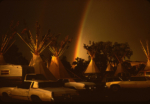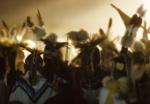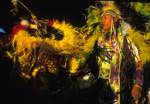Textured Portraits: The Ken Blackbird Collection; Photography from the Buffalo Bill Center of the West, is a traveling exhibition of the work of Ken Blackbird, a photojournalist with 30 years of experience photographing Native life on reservations in Montana and Wyoming. The 30 photographs selected for Textured Portraits reflect Mr. Blackbird’s exceptional visual artistry. His subjects are expressed in a range of photographic genres, from action photos to abstract studies of light and shadow.
Quiet portraits of tribal elders are juxtaposed with night scenes at Crow Fair, behind-the-scenes glimpses of the Cody Stampede rodeo, and such activities as ranching and rural life on the Fort Belknap Reservation, where he is an enrolled Assiniboine member of the community. He offers what have elsewhere been described as “textured portraits of life,” studies of people “interwoven with their environment or steeped in their rituals.”
Blackbird captures the vitality of Native life. Unlike romantic figures seen in historic photographs, he makes images of “life as it should be – the people still holding powwows and ceremonies, and knowing that they always will.” The collection also includes oral history interviews with his subjects, reflecting his dedication to the people he photographs.
Ken Blackbird sees his work as a continuum. Instead of telling stories in the old ways – on painted hides or ledger books – he captures history with a camera. When visiting home, or other reservations, he always enjoys meeting people and spending time with them, and recording these moments in images. Blackbird has learned to take good pictures to honor his subjects and knows it is important to follow cultural protocol, even as a tribal member. The process can be a slow one, but the time spent brings opportunities to visit and learn–and often brings the unexpected to the photographs.
Textured Portraits: The Ken Blackbird Collection; Photography from the Buffalo Bill Center of the West is organized by the Buffalo Bill Center of the West, Cody, Wyoming, with support from the Wyoming Arts Council; WESTAF, the Western States Arts Federation; Wyoming Humanities Council; and the National Endowment for the Arts.





